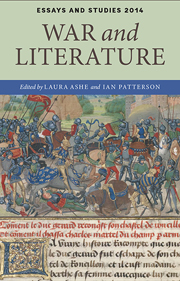Book contents
- Frontmatter
- Contents
- List of Illustrations
- Notes on Contributors
- Preface
- I IDEOLOGIES
- II INTERPRETATIONS
- III AFTERMATHS
- A Feeling for Numbers: Representing the Scale of the War Dead
- The Guilt of the Noncombatant and W. H. Auden's ‘Journal of an Airman’
- Does Tolstoy's War and Peace Make Modern War Literature Redundant?
- Index
Does Tolstoy's War and Peace Make Modern War Literature Redundant?
from III - AFTERMATHS
Published online by Cambridge University Press: 05 October 2014
- Frontmatter
- Contents
- List of Illustrations
- Notes on Contributors
- Preface
- I IDEOLOGIES
- II INTERPRETATIONS
- III AFTERMATHS
- A Feeling for Numbers: Representing the Scale of the War Dead
- The Guilt of the Noncombatant and W. H. Auden's ‘Journal of an Airman’
- Does Tolstoy's War and Peace Make Modern War Literature Redundant?
- Index
Summary
People who have read War and Peace more than once, and enjoyed it immensely, can often scarcely remember a thing about it.
The concept of redundancy employed in this essay is the one used in mathematics and linguistics to designate symbols that do not add information to a sequence. One of the hazards of teaching twentieth-century war literature is the tacit inference of redundancy by readers, namely that the representational conventions as well as the facts and values represented are ‘predictable from … context’. The claim that twentieth-century war writing is made superfluous by War and Peace (1869) is polemical, but it is also intended to do serious work: to draw attention to representations of war which are not predictable from context, and to renew questions such as why representing war as irrational, murderous activity is unefficacious, and why we would imagine otherwise.
The designs of War and Peace as war writing can be recognised as early as 1853, when Tolstoy published a story drawing on his own military experience in the Caucasus:
War always interested me: not war in the sense of manoeuvres devised by great generals – my imagination refused to follow such immense movements, I did not understand them – but the reality of war, the actual killing. I was more interested to know in what way and under the influence of what feeling one soldier kills another than to know how the armies were arranged at Austerlitz and Borodino.
- Type
- Chapter
- Information
- War and Literature , pp. 228 - 248Publisher: Boydell & BrewerPrint publication year: 2014

